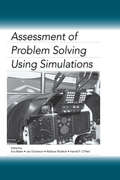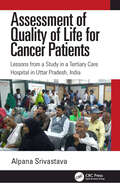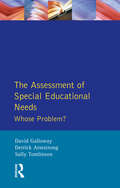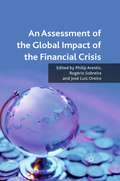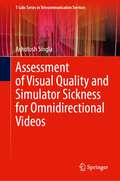- Table View
- List View
Assessment of Problem Solving Using Simulations
by Eva Baker Jan Dickieson Wallace Wulfeck Harold F. O’NeilThis volume explores the application of computer simulation technology to measurement issues in education -- especially as it pertains to problem based learning. Whereas most assessments related to problem solving are based on expensive and time consuming measures (i.e., think-aloud protocols or performance assessments that require extensive human rater scoring), this book relies on computerization of the major portion of the administration, scoring, and reporting of problem-solving assessments. It is appropriate for researchers, instructors and graduate students in educational assessment, educational technology, and educational psychology.
Assessment of Problem Solving Using Simulations
by Harold F. O'Neil Eva Baker Jan Dickieson Wallace WulfeckThis volume explores the application of computer simulation technology to measurement issues in education -- especially as it pertains to problem based learning. Whereas most assessments related to problem solving are based on expensive and time consuming measures (i.e., think-aloud protocols or performance assessments that require extensive human rater scoring), this book relies on computerization of the major portion of the administration, scoring, and reporting of problem-solving assessments. It is appropriate for researchers, instructors and graduate students in educational assessment, educational technology, and educational psychology.
The Assessment of Psychosis: A Reference Book and Rating Scales for Research and Practice
by Flavie Waters Massoud StephaneThis book reviews the descriptive features of psychotic symptoms in various medical conditions (psychiatric, early psychosis, general medical, neurological and dementia), non-medical settings (individuals without the need for care or at high risk for psychosis) and age groups (children and adolescents, adults, older adults). Similarly, the perspectives of many disciplines are provided (history, psychiatry, psychology, psychopathology, neurology, phenomenological philosophy) so that readers may become familiar with different approaches that are used to define, evaluate and categorize psychosis, at times independently of clinical diagnosis. This book is a resource book for those requiring an understanding of clinical and conceptual issues associated with psychosis, with chapters written by academics and clinicians who are leaders in their respective fields. The book also provides a guide regarding the methods of assessment for psychosis and its symptoms, with 120 rating scales, which are described and evaluated. The Assessment of Psychosis will be particularly useful to the clinical and research community, but also to readers interested in individual differences and human psychopathology.
The Assessment of Psychosis: A Reference Book and Rating Scales for Research and Practice
by Flavie Waters Massoud StephaneThis book reviews the descriptive features of psychotic symptoms in various medical conditions (psychiatric, early psychosis, general medical, neurological and dementia), non-medical settings (individuals without the need for care or at high risk for psychosis) and age groups (children and adolescents, adults, older adults). Similarly, the perspectives of many disciplines are provided (history, psychiatry, psychology, psychopathology, neurology, phenomenological philosophy) so that readers may become familiar with different approaches that are used to define, evaluate and categorize psychosis, at times independently of clinical diagnosis. This book is a resource book for those requiring an understanding of clinical and conceptual issues associated with psychosis, with chapters written by academics and clinicians who are leaders in their respective fields. The book also provides a guide regarding the methods of assessment for psychosis and its symptoms, with 120 rating scales, which are described and evaluated. The Assessment of Psychosis will be particularly useful to the clinical and research community, but also to readers interested in individual differences and human psychopathology.
Assessment of Quality of Life for Cancer Patients: Lessons from a Study in a Tertiary Care Hospital in Uttar Pradesh, India
by Alpana SrivastavaCancer is a deadly disease that puts not only physical and financial pressure on the patient but also even more psychological pressure. Physical deterioration in health and financial losses are easy to see but the psychological effects are not as visible; however, the psychological aspects are an important component in measuring any patient’s Quality of Life (QoL, or balance between physical, psychological, social, and spiritual components).The present study is a small step in the direction of measuring QoL of cancer patients and the potential positive impact of changes in counselling. The association between QoL and other parameters, especially fear, leads to the recommendation to set up counselling centres at each hospital in its oncology department.
Assessment of Quality of Life for Cancer Patients: Lessons from a Study in a Tertiary Care Hospital in Uttar Pradesh, India
by Alpana SrivastavaCancer is a deadly disease that puts not only physical and financial pressure on the patient but also even more psychological pressure. Physical deterioration in health and financial losses are easy to see but the psychological effects are not as visible; however, the psychological aspects are an important component in measuring any patient’s Quality of Life (QoL, or balance between physical, psychological, social, and spiritual components).The present study is a small step in the direction of measuring QoL of cancer patients and the potential positive impact of changes in counselling. The association between QoL and other parameters, especially fear, leads to the recommendation to set up counselling centres at each hospital in its oncology department.
Assessment of Risk from Low-Level Exposure to Radiation and Chemicals: A Critical Overview (Basic Life Sciences Ser. #33)
by A. D. WoodheadThe present workshop had its orlglns in discussions among Alexander Hollaender, Oddvar Nygaard, Donald Borg, Richard Setlow and Victor Bond on the need for a symposium that would deal with a broad spectrum of pressing subjects related to the physics, chemistry, and biological actions of ionizing radiations, and the theoretical and practical problems of risk assessment. It soon became apparent that the spectrum of subjects considered was too broad for the desired depth of coverage; in fact, it seemed un likely that the conference participants would have the background knowledge to span the gamut. Therefore, two separate meetings were decided upon, the first of which, Comparison of Mechanisms of Carcinogenesis by Radiation and Chemical Agents, was held at the National Bureau of Standards, Gaithersburg on December 6-7, 1983. The meeting was sponsored by the NCI. The second meeting has emerged as the present workshop at Brookhaven National Laboratory. An interface between the two conferences has been provided by Michael Fry and Donald Borg, who have summarized the salient points emanating from the NCI Symposium. We intended that the first conference should focus on the basic mechanisms of radiation and chemical carcinogenesis, while the second, the present meeting, would emphasize exposure-response relationships, particularly the theoretical and practical similar ities and differences between exposure to chemical carcinogens compared to exposure to ionizing radiation.
The Assessment of Special Educational Needs: Whose Problem?
by David M Galloway Derrick Armstrong Sally TomlinsonThe debate about special needs provision has increased dramatically over the last 15 years, however, despite the widespread concern over both learning and behavioural difficulties, there have been few attempts to analyse in detail the process of assessment by which children are being identified as having special educational needs. Drawing upon research carried out by the authors, this book fills that gap by examining the process in detail. It considers the assessment process itself and how it affects and is affected by other areas of school policy - in some cases causing tension and conflict such as parental participation, the use and allocation of resources and multi-professional decision-making. A feature of the book is its analysis of the impact of the National Curriculum and the local management of schools (LMS) provision for special needs.
The Assessment of Special Educational Needs: Whose Problem?
by David M Galloway Derrick Armstrong Sally TomlinsonThe debate about special needs provision has increased dramatically over the last 15 years, however, despite the widespread concern over both learning and behavioural difficulties, there have been few attempts to analyse in detail the process of assessment by which children are being identified as having special educational needs. Drawing upon research carried out by the authors, this book fills that gap by examining the process in detail. It considers the assessment process itself and how it affects and is affected by other areas of school policy - in some cases causing tension and conflict such as parental participation, the use and allocation of resources and multi-professional decision-making. A feature of the book is its analysis of the impact of the National Curriculum and the local management of schools (LMS) provision for special needs.
Assessment of Student Achievement (Ed Psych Insights)
by Gavin T. BrownAssessment is a concept familiar across the field of education and is inherent to the work of professors, administrators, teachers, researchers, journalists, and scholars. A multifaceted and politically charged topic, assessment ranges from informal interactions with learners in classrooms to systematic high-stakes testing and examination. Written by a leading expert on assessment, this book situates the topic within the broader context of educational psychology research and theory and brings it to a wider audience. With chapters on the fundamentals of assessment, explanations of its uses, and advice for best application, this concise volume is designed for any education course that includes assessment in the curriculum. It will be indispensable for student researchers and both pre- and in-service teachers alike.
Assessment of Student Achievement (Ed Psych Insights)
by Gavin T. BrownAssessment is a concept familiar across the field of education and is inherent to the work of professors, administrators, teachers, researchers, journalists, and scholars. A multifaceted and politically charged topic, assessment ranges from informal interactions with learners in classrooms to systematic high-stakes testing and examination. Written by a leading expert on assessment, this book situates the topic within the broader context of educational psychology research and theory and brings it to a wider audience. With chapters on the fundamentals of assessment, explanations of its uses, and advice for best application, this concise volume is designed for any education course that includes assessment in the curriculum. It will be indispensable for student researchers and both pre- and in-service teachers alike.
Assessment of the Fate and Effects of Toxic Agents on Water Resources (Nato Security through Science Series C:)
by I. Ethem Gonenc Vladimir G. Koutitonsky Brenda Rashleigh Robert B. Jr Ambrose John P. WolflinWater has become one of the potential targets of terrorists. This volume addresses the basic scientific concepts that must be integrated by decision-makers to minimize damages and optimize recovery operations in the aftermath of such an attack. It addresses the multidisciplinary approaches for rapid diagnoses and assessments, and offers a step-by-step treatment of all aspects of ecosystem processes, modelling and monitoring.
Assessment of the Fate of Surrogates for Enteric Pathogens Resulting From the Surcharging of Combined Sewer Systems (IHE Delft PhD Thesis Series)
by Iosif Marios ScoullosIn the last ten years (2009-2019), flooding caused the death of over 48,000 people, and affected over 697 million people globally. This is expected to increase as a result of climate change, population growth and urbanisation. Floods can cause infections due to the release of water-borne pathogens from surcharged combined sewers and other sources of faecal contamination on urban surfaces such as concrete, asphalt, gravel, pavement, playground rubber tiles and grass. Using laboratory experiments with faecal indicator bacteria Escherichia coli, and with Bacillus subtilis spores, and MS2 bacteriophages under controlled exposure to simulated sunlight, this research contributes towards a better understanding of the environmental parameters that affect the concentration of pathogens in contaminated shallow water bodies and on different urban surfaces. Also, several sampling methods are assessed for the recovery of bacteria from flood-prone urban surfaces. This study suggests that given the sunlight conditions after an urban flood, the concentration of indicator organisms and of total suspended solids and the surface type it is possible to estimate the fate of selected pathogens. The observations and results presented in this study contribute to the development of policy-making tools for rapid implementation of appropriate measures to mitigate public health risks after flooding. This book:- highlights the relation of urban floods with water-borne diseases.-stresses for the first time the importance of urban surfaces (pavement, concrete, asphalt, etc.) on the inactivation of water-borne pathogens.-provides equations that can be used to develop policy-making tools for implementation of appropriate measures to mitigate public health risks after flooding.
Assessment of the Fate of Surrogates for Enteric Pathogens Resulting From the Surcharging of Combined Sewer Systems (IHE Delft PhD Thesis Series)
by Iosif Marios ScoullosIn the last ten years (2009-2019), flooding caused the death of over 48,000 people, and affected over 697 million people globally. This is expected to increase as a result of climate change, population growth and urbanisation. Floods can cause infections due to the release of water-borne pathogens from surcharged combined sewers and other sources of faecal contamination on urban surfaces such as concrete, asphalt, gravel, pavement, playground rubber tiles and grass. Using laboratory experiments with faecal indicator bacteria Escherichia coli, and with Bacillus subtilis spores, and MS2 bacteriophages under controlled exposure to simulated sunlight, this research contributes towards a better understanding of the environmental parameters that affect the concentration of pathogens in contaminated shallow water bodies and on different urban surfaces. Also, several sampling methods are assessed for the recovery of bacteria from flood-prone urban surfaces. This study suggests that given the sunlight conditions after an urban flood, the concentration of indicator organisms and of total suspended solids and the surface type it is possible to estimate the fate of selected pathogens. The observations and results presented in this study contribute to the development of policy-making tools for rapid implementation of appropriate measures to mitigate public health risks after flooding. This book:- highlights the relation of urban floods with water-borne diseases.-stresses for the first time the importance of urban surfaces (pavement, concrete, asphalt, etc.) on the inactivation of water-borne pathogens.-provides equations that can be used to develop policy-making tools for implementation of appropriate measures to mitigate public health risks after flooding.
An Assessment of the Global Impact of the Financial Crisis
by Philip Arestis, Rogéo Sobreira & Joséuis OreiroThis topical volume analyzes the impact of the 2008 financial crisis. It considers the origins and explanations of the current crisis, examines the regulatory implications and, with specific focus on developing countries, it provides a strategy for economic growth that can guarantee financial stability in the future.
Assessment of the Nuclear Programs of Iran and North Korea
by Jungmin KangWhen we are looking at proliferation cases, there are a number of lessons – positive and negative – learnt. First, facts reported by the IAEA are essential for the international community in assessing the compliance and risks of possible clandestine activities. Second, the IAEA verification scheme is biting when it fully exercises its verification rights, and when it is provided with the requisite cooperation. Third, when countries face questions raised by the IAEA, those that chose to turn the course and / or cooperated to remove concerns and ambiguities resolved their nuclear dossiers in a satisfactory manner and fairly swiftly. Fourth, when states adopt the course of confrontation, as are currently the cases with Iran, Syria and North Korea, the situation becomes more complicated and more difficult to resolve. Fifth, dragging non-compliance and challenging of the authority of the United Nations Security Council and the IAEA Board of Governors erodes the international non-proliferation regime. This book addresses two proliferation cases, Iran and North Korea providing extensive snapshots on the currently known nuclear programs, and analyses failures and weaknesses of past verification activities, and makes innovative suggestions for ways forward.
Assessment of the Use of Single Cytochrome P450 Enzymes in Drug Research (Ernst Schering Foundation Symposium Proceedings #13)
by M. R. Waterman M. HildebrandAssessment of Total Evacuation Systems for Tall Buildings (SpringerBriefs in Fire)
by Enrico Ronchi Daniel NilssonThis SpringerBrief focuses on the use of egress models to assess the optimal strategy for total evacuation in high-rise buildings. It investigates occupant relocation and evacuation strategies involving the exit stairs, elevators, sky bridges and combinations thereof. Chapters review existing information on this topic and describe case study simulations of a multi-component exit strategy. This review provides the architectural design, regulatory and research communities with a thorough understanding of the current and emerging evacuation procedures and possible future options. A model case study simulates seven possible strategies for the total evacuation of two identical twin towers linked with two sky-bridges at different heights. The authors present the layout of the building and the available egress components including both vertical and horizontal egress components, namely stairs, occupant evacuation elevators (OEEs), service elevators, transfer floors and sky-bridges. The evacuation strategies employ a continuous spatial representation evacuation model (Pathfinder) and are cross-validated by a fine network model (STEPS). Assessment of Total Evacuation Systems for Tall Buildings is intended for practitioners as a tool for analyzing evacuation methods and efficient exit strategies. Researchers working in architecture and fire safety will also find the book valuable.
Assessment of Toxic Agents at the Workplace: Roles of Ambient and Biological Monitoring
by A. Berlin R. E. Yodaiken W. A. Hanman1.1 Organisation and aims This International Seminar, organised jointly by the Com mission of the European Communities and the United States authorities (Occupational Safety and Health Administration and the National Institute for Occupational Safety and Health) has brought together more than 150 participants from the Member States of the European Community, from the United States, and also from Greece, Finland, Sweden and Switzer land. The aim of the Seminar was to examine the roles of ambient and biological monitoring in protecting the health of workers exposed to toxic agents and to define a multidisciplinary approach to this monitoring. To achieve this aim expertise from the following disciplines, directly or indirectly involved with monitoring, was called upon: medicine, industrial hygiene, nursing, biology, engi neering, chemistry, epidemiology, statistics, economics and jurisprudence, and representatives from trade unions, indus try and government agencies. The difference in concepts that each of these disciplines has of monitoring and of its role in the team is fully reflected in the papers. 1.2 Current trends in occupational health and hygiene (as related to monitoring).
Assessment of Tumour Response (Developments in Oncology #11)
by B. W. Hancock MD, DCH, MRCPThe assessment of tumour response after treatment is one of the most important challenges in Oncology and the picture is so often complicated by the effects of therapy itself. Clinical assessment is still by far the most important method of assessment at our disposal but there is increasing dependence on investigations of all types as indices of response. This depen dence may be misplaced if inappropriate investigations are pursued and we have tried to emphasise in this book the importance of selectivity. Some indices of assessment (e. g. tumour markers, organ imaging) have a vital role to play; others (e. g. histopathology, genetics) are assuming greater impor tance as tumour behaviour becomes better understood. One subject, Immu nology, is still in its infancy as regards tumour follow-up, but shows much promise so that a full account of tumour immunology and trends in immu notherapy has been included. I am grateful to Dr. Brian Ross for his help with the chapter on Organ Imaging, to the Department of Medical Illustration for their ever-ready co-operation with illustrations and photographs and to Miss Shirley Francis for doing much of the typing. B. W. HANCOCK List of Contributors HANCOCK, B. W. , MD, DCH, MRCP, Senior Lecturer in Medicine, Hon orary Consultant Physician, Royal Hallamshire & Weston Park Hospitals, Sheffield, U. K. NEAL, F. E. , KSG, MBChB, FRCR, DMRT, Consultant Radiotherapist & Oncologist, Weston Park Hospital, Sheffield, u. K. POTTER, AM.
Assessment of Urinary Sediment by Electron Microscopy: Applications in Renal Disease
by A.K. MandalAnil K. Mandai, M.D., is one of the trailblazers in the use of the transmission electron microscope in the study of the urinary sediment. In this book, he reviews his extensive efforts to tie his vast clinical expe rience to his elegant basic research with the electron microscope. The pictures are comprehensive, and the clinical correlates are nicely outlined in tables and text. It may astonish some readers that a book for fellows and clinical nephrol ogists has been written on the use of the transmission electron microscope in the study of urine. Some may view this as a sophisticated research instrument. I, however, applaud the effort. So many discoveries and advances in basic science lie unutilized because clinicians are not aware of the tools available or have little instruction in their use. Maybe that is the reason why so many tests have come and gone, have been found useless and dropped, or have simply been abandoned after being judged too complicated-some because they were, others because they were never applied and interpreted properly. The whole field of research seems to be pulling ahead and away from clinical medicine. Therefore, an effort like this one, which rapidly and clearly tries to introduce an advanced research examination technique into clinical medicine, is worthy of admiration and sup port.
Assessment of Ventricular Function (Springer Praxis Books #21)
by Angelo Raineri Robert D. Leachman Jan J. KellermannThis is the 3rd Course that has been organized at the presti gious E. Majorana Centre. The choice of the theme is not a casual one. In fact after rehabilitation and prevention which were the topics discussed in the previous courses of 1979 and 1982, this Course deals with subjects more deeply connected with the mechanisms of cardiac function and the pathological aspects that under this point of view characterize many specific diseases. The rapid development in the application of technology to the problems of Cardiological diagnosis has made it possible to study ventricular function in the evaluation of patients with apparent or suspected heart disease. Knowing that we are facing one of the most complex subjects in modern cardiology we wish to arouse the interest of researchers anrl cardiologists by comparing different experiences with the aim of giving an overall survey of the problems. The program has been divided into 4 chapters: 1. Systolic and diastolic ventricular function. 2. Specific studies of ventricular function using invasive and non invasive techniques. 3. Diseases with altered ventricular function. 4. Pharmacological manipulation of ventricular function. Our aim is not only to stimulate useful discussions in the faculty but also among the participants. I hope that we can achieve this. I should like to take this opportunity of thanking the co directors of the Course Prof. Jan Kellermann and Prof. Robert v vi PREFACE Leachman who have played an important part in the scientific organization.
Assessment of Visual Quality and Simulator Sickness for Omnidirectional Videos (T-Labs Series in Telecommunication Services)
by Ashutosh SinglaThis book presents extensive research on the quality of 360° video perceived by users with HMDs. The book aims to develop a set of standard guidelines for the systematic visual quality assessment of 360° videos. Firstly, conventional subjective test methods such as Absolute Category Rating (ACR) and Double Stimulus Impairment Scale (DSIS) are applied to evaluate video quality, alongside the Modified ACR (M-ACR) method newly proposed. Building on the reliability and general applicability of the procedure across different tests, a methodological framework for 360° video quality assessment is then presented. The author also analyzes simulator sickness to investigate the impact of different influencing factors. The insights gained on simulator sickness related to 360° video contribute to a better understanding of this particular use case of VR and can help to improve comfort among users by suggesting improvements in the technical specifications of 360° video and HMD technology and thus improving QoE.
Assessment of Young Children: A Collaborative Approach
by Lisa B. FioreIn an era of standards and norms where assessment tends to minimize or dismiss individual differences and results in punitive outcomes or no action at all, Assessment of Young Children provides teachers with an approach to assessment that is in the best interest of both children and their families. Author Lisa B. Fiore explores a variety of ways to study and assess young children in their natural environments, while stressing the importance of bringing children and families into the process. This lively text helps the reader learn how to cultivate developmentally appropriate practice, create appropriate expectations, examine children’s work, interact in groups, and improve their teacher behavior. Accounts of real experiences from children, families, teachers, and administrators provide on-the-ground models of assessment stategies and demonstrate how children are affected. Assessment of Young Children explores both standardized and authentic assessment, work sampling systems, and observation skills. Readers will walk away with strategies for communicating information about children and portfolio assessment, and how the use of formal and informal methods of observation, documentation, and assessment are connected to teacher and student inquiry. Assessment of Young Children encourages an assessment strategy where the child remains the focus and explores how collaboration with children, families, and colleagues creates an image—not a diagnosis—of the child that is empowering rather than constraining. Special Features Include: Case Study examples that anchor the concepts presented in the chapters and engage readers more deeply in the content. "Now what?" and "Avenues for Inquiry" throughout the book present students with concrete extensions of the material that they may pursue for further investigation
Assessment of Young Children: A Collaborative Approach
by Lisa B. FioreIn an era of standards and norms where assessment tends to minimize or dismiss individual differences and results in punitive outcomes or no action at all, Assessment of Young Children provides teachers with an approach to assessment that is in the best interest of both children and their families. Author Lisa B. Fiore explores a variety of ways to study and assess young children in their natural environments, while stressing the importance of bringing children and families into the process. This lively text helps the reader learn how to cultivate developmentally appropriate practice, create appropriate expectations, examine children’s work, interact in groups, and improve their teacher behavior. Accounts of real experiences from children, families, teachers, and administrators provide on-the-ground models of assessment stategies and demonstrate how children are affected. Assessment of Young Children explores both standardized and authentic assessment, work sampling systems, and observation skills. Readers will walk away with strategies for communicating information about children and portfolio assessment, and how the use of formal and informal methods of observation, documentation, and assessment are connected to teacher and student inquiry. Assessment of Young Children encourages an assessment strategy where the child remains the focus and explores how collaboration with children, families, and colleagues creates an image—not a diagnosis—of the child that is empowering rather than constraining. Special Features Include: Case Study examples that anchor the concepts presented in the chapters and engage readers more deeply in the content. "Now what?" and "Avenues for Inquiry" throughout the book present students with concrete extensions of the material that they may pursue for further investigation
